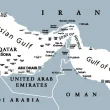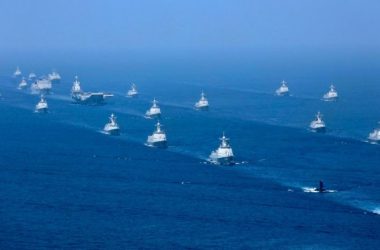Sarawak politics appears largely unchanged with the ruling BN in power, Abdul Taib Mahmud the Chief Minister for 30 years. However, a closer look reveals there has a trend and issues that could complicate the dynamic of state politics.
Based on census that has been done in 2000, Sarawak is a predominantly non-Muslim state which accounts 71.1%. Unlike Peninsula Malaysia, no single ethnic group in Sarawak forms a majority. When Malayan Prime Minister Tunku Abdul Rahman proposed new federation of Malaysia, Sarawak and Sabah were invited to join Singapore and Brunei in the new entity, figuring the numerically strong Bumiputra population would offset the large Chinese population of Singapore in the new political grouping. As an incentive, Sarawak and Sabah accorded special provision which gave them greater autonomy compare to other state of Malaya. However, the special rights of Sarawak were eroded by federal government over time.
BN has dominated Sarawak politics for the last four decades. But, there have been significant changes in this coalition due several reasons. These changes can be divided into seven phases which are (1) formative years, (2) post 1970 elections, (3) co-optation of Snap, (4) the BN3 Plus Government, (5) the BN3 government, (6) Dayak consolidation and (7) Dayak leadership crisis.
In the first phase, ruling coalition known as Sarawak United Front (SUF) was established in 1962 and consists of four component party and each of them predominantly comprised of single ethnic group. These component parties were Barisan Rakyat Jati Sarawak (BARJASA), Sarawak Chinese Association (SCA), Sarawak National Party (SNAP), and Parti Pesaka Anak Sarawak (PESAKA). First elected government was led by SNAP and Stephen Kalong Ningkan was appointed as Chief Minister. Few years later, ruling coalition faced major crisis and led to ouster of Ningkan and withdrawal of SNAP from SUF. BARJASA leaders were able to dominate the state cabinet although it was led by PESAKA leader, Tawi Sli. PANAS rejoin the coalition just before removal of Ningkan. Domination of Muslim Bumiputra leaders were consolidated when BARJASA and PANAS merged and formed BUMIPUTRA in 1966.
Second phase is post 1970 elections. In 1970 elections, SUF faced a challenge from opposition which comprised of SNAP and SUPP. However, it still manages to secure enough seats. PESAKA want its leader to be the chief minister but BUMIPUTRA refused due to greater electoral strength. Therefore, BUMIPUTRA with the support of federal leaders made a plan to co-opt SUPP into new alliance known as Perikatan. SCA was dissolved in compliance with SUPP. BUMIPUTRA party led the new coalition and Abdul Rahman Yakub was appointed for the third chief minister. In this phase, BUMIPUTRA and PESAKA merged and formed PBB. This allowed them to consolidate their strength. In the same year, the coalition was renamed the Barisan Nasional.
Third phase is co-optation of SNAP. It occurs after 1974 elections when chief minister faced dissent within SUPP and sensed the need to find new senior partner. Therefore, he decided to co-opt with SNAP in order to consolidate his position. This cause the opposition force severely weakened. Then, SNAP faced leadership crisis and another Dayak party was formed which is Parti Bansa Dayak Sarawak (PBDS). Taib Mahmud accepted PBDS’s application to join BN although there was a protest from SNAP. This cause weakend Dayak parties but strengthen the position of PBB. This was known as BN3 plus government. This is fourth phase.
Phase 5 is the BN3 government. This occurs when PBDS backfired BN when it teamed up with a group of disgruntled PBB and SNAP leaders. PBDS then left Sarawak BN but remained a member of BN alliance at national level. PBDS then teamed up with PERMAS and formed Kumpulan Maju as opposition. Now, BN only has PBB, SUPP and SNAP and known as BN3 government. However after 1991 elections, PBDS returned to ruling coalition.
The last phase is Dayak Crisis. Dayak leadership crisis cause formation of another parties which are Sarawak Progressive Democratic Party (SPDP) which is breakaway party from SNAP and Parti Rakyat Sarawak which is breakaway party from PBDS. Both of them were allocated the same parliamentary and state seat contested by their origin party. Currently, Sarawak BN is dominated by PBB and it achieved its prominent status within the state ruling coalition ever since Rahman Yakun as chief minister.
Up to 1970s, there was no alliance formed between the opposition parties. Ruling BN co-opted influential Dayak party into coalition and led to the decline of Sarawak opposition forces. Although new opposition parties were formed, none of them posed any serious challenge and most of them could not survive beyond two elections due to dismal electoral performance and lack of financial resources. In 1970s also, a national based party entered Sarawak which is DAP. It was founded by several SUPP leaders who are not happy with the party leadership and it was the only national party in Sarawak at that time. Its contribution is the ability to sustain the opposition struggle which state based party failed to achieve. There also had independent candidates who contested in 1983 elections and they were able to snatches 3 seats from ruling party. The reasons of independent party contested because they did not believed in the ideological struggles and leadership of existing opposition parties and also was planned by the ruling party in order to divide the opposition’s vote. In 1990s, reformasi (reform) movement that erupts in the Peninsula spread to Sarawak and that is the first time KeADILAN and PAS contested in Sarawak. KeADILAN was brought from Anwar supporters and PAS made a quiet entry through its social engagement programme which special emphasis in dakwah. This change the make-up of Sarawak’s opposition forces from regional to national-based. In 1999 elections, KeADILAN, DAP, and PAS formed Barisan Alternatif however it lasted only few months due to the absence of unifying leader. Nowadays, the backbone of the opposition coalition is made up of coalition of national parties known as Pakatan Rakyat. Clearly the opposition coalition in Sarawak has relied heavily on the durability of the national coalition to sustain it. There also has fragmentation of opposition forces in Sarawak due to contestation between national and regional sentiments within the alliance. PR has pursued regional issued in order to appease anti-Peninsula sentiments within Sarawak society and the coalition itself.
The other issue is leadership transition. Abdul Taib Mahmud was the man at the centre of controversy. He took over state leadership from his uncle, Abdul Rahman Yakub. Critics along with federal leaders’ impatience to see a leadership transition taking place have put a lot pressure on Taib. He had raised the issue of retirement several times before and the first time was in 1995. He announced three candidates which were Effendi Norwawi, Adenan Satem and Abang Johari. However, Taib was expected to handpick his successor who would not only ensure the continuity of Muslim Bumiputra rule in Sarawak and sustain the dominance of PBB in the ruling coalition, but also protect his family interest. However, next chief minister will face daunting task in consolidating his position. There will be challenge from opposing factions in his own party, other component parties of the ruling coalition and opposition. These opposing forces could either attempt to bring down the newly appointed chief minister or want to test the power of the new strongman-politician.
Other issues are revolt of the Chinese voters and the rises of the Bumiputra intelligentsia. One of the emerging trends in Sarawak’s politics is gradual swing of Chinese support away from the ruling party. During formative years of Malaysia, Chinese voters were considered staunch supporters of the opposition which was SUPP which opposed the formation of new nation. After SUPP join ruling coalition, the voters persistently supported the ruling party. However, domination of SUPP over Chinese voter ended abruptly in 1996 when its president failed to defend his seat which losing to DAP. There have a few reasons of revolt emerged of Chinese voters. Survey was done by Merdeka Center on 518 respondents. The reasons are the voters were pessimistic about the prospects for national economy and felt dejected over perceived marginalization of the community, Muslim Melanau-led government had implemented policies which favors Muslim Bumiputra and weak leadership within ruling coalition, intra-party rivalries, money politics and corruptions. Chinese voters seem to be more susceptible to change compare to Bumiputra because they reside at the urban area. Besides, there also growing number of Dayak intelligentsia who are bold enough to challenge traditional Dayak families and Muslim Bumiputra elites. There are dozens of blogs run by Dayak intelligentsia and most of them expose the corrupt practice of Sarawak BN. They align themselves to PKR and SNAP. Compare to Chinese, it is difficult to assess the sentiments of Dayak voters.
As a conclusion, change already taking place in Sarawak politics. There are some manifestations of changes such as fragmentation of ruling coalition, the changing face of opposition parties, imminent retirement of Taib, revolt Chinese voters and emergence of Dayak intelligentsia that have been generated by the state’s attempt to dominate Sarawak’s electorate and the contests mounted against this domination by various forces in society.
Reference:
- Faisal S Hazis, 2011. Wind of Change in Sarawak Politics?
Ahmad Harith
IKB Researcher










